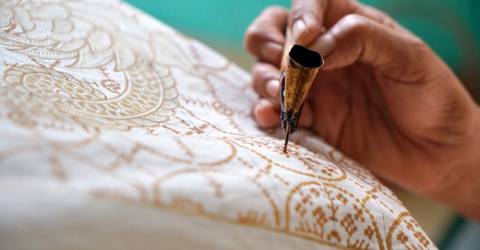Read on to learn more about five textiles that have been held as examples of their nation’s cultural heritage
THE different fabrics from throughout the world are one thing that everyone finds intriguing. Bold and fascinating textiles come in a wide variety, and they all have intricate designs and brilliant colours that are just as intriguing. Every culture has traditionally placed textiles at the centre of its sense of self, with each nation having its own distinctive fabric that reflects its identity.
One could hesitate to refer to it as just ‘cloth’ given the intention and laborious work that went into the design, colour schemes, and pattern selections. They serve as a showcase of culture and a means of transmitting history. Nevertheless, the industry faces many challenges. These days, local craftspeople face competition from mass-produced fabrics, and fight to survive in a volatile economy. The availability of raw resources is hampered by global warming. The next generation of craftsmen are taking up higher paid employment to meet their needs.
Authentic fabrics might take weeks to make, and there is just not enough revenue flow between sales. Some of the most talented weavers are frequently compelled to use simpler patterns in order to sell to visitors searching for low-cost gifts. However, there is a growing movement aroung the world to revive interest in regional crafts. Many young people are also open to learning more about handmade crafts.
Here are five countries that produce some really beautiful and unique textiles.
Indonesia
Traditional fabrics from Indonesia come in a lot of varieties. The fact that Indonesia is an island of hundreds of islands is one factor contributing to the wide variation. Batik and ikat are the traditional items to bring home. Although they were developed in Java, these wax-resistant dyeing techniques are used all throughout the islands. On fine cotton cloth (batik) or straight on the threads that will be woven, liquid is painted in a variety of designs (ikat).
The wax-blocked patterns block the dye when they are soaked in layers of multicoloured dyes, resulting in a cloth with gorgeous patterns, pictures, and symbolic motifs. Although the finished fabric can also be coloured, the ikat textiles’ patterns are made by colouring the threads. Decorative tenum ikat designs often appear on ceremonial garments and feature cosmological and everyday symbolism.
India
The Romans reportedly adored Bengal khadi (a fabric with a 5,000-year-old history) for its softness. But in the 1920s, it was Mahatma Gandhi himself who popularised the textile. In order to promote Indian self-reliance and dissuade people from purchasing imported British apparel, the leader of the Indian independence movement encouraged wearing locally-created clothing. This textile, which is made of cotton, silk, or wool, is always handspun and handwoven. It is thin, incredibly strong, and frequently plainly coloured when made into tunics and jackets. Even some Indian fashion designers have started adding the material into their most recent lines, fusing it with denim.
Japan
Yuzen is a dye-resisting technique frequently used to create kimono fabric, and is distinguished by delicate sketching of floral, avian, and human figures. Yuzen, which dates back to the 14th century, developed from simple, one-colour dyes to multicoloured, intricately patterned patterns that are a modern representation of Japan. The fabric is initially shaped into the style of a kimono to make the traditional outfit. Before the fabric is dip-dyed, the pattern is traced using rice paste. The first white lines are where the masterpiece begins. The paste helps to protect the regions the artist does not want to colour while other colours are then manually applied with a brush. The final touches – a smoothing of the dry paint and a steaming procedure to remove the paste – are essential. These days, kimonos are donned either professionally and casually, and Western designers have produced replicas of them.
Philippines
The delicate and cutting-edge textile known as pina is produced in Aklan, Philippines, from pineapple fibres to create an environmentally friendly and sustainable filament that can be used to make clothes like the Barong Tagalog, the country’s traditional dress, or embellished with calado, a type of Filipino embroidery style. Today, vegan leather and footwear are being produced using this age-old method.
Guatemala
Jaspe is a kind of regional resist-dyed fabric that has a wide range of colours and pattern variations, and is prized for its toughness and tenacity. The weave structure itself is usually plain weave and it can be woven on backstrap or treadle looms, warped faced with vertical designs, weft-faced with horizontal lines, or balanced weave with jaspe designs going in both directions. Simple jaspe is woven in many villages throughout Guatemala. When produced from jaspe cloth, as has been customary for the previous few hundred years, the long, rectangular scarf known as a rebozo is a representation of the blending of those two civilisations. It is used for both head covering in church and carrying newborns and other heavy objects.
